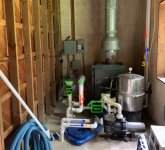I'm about to do this myself - I'm curious most about the placement of the probes. I'm planning to use the tee with the 1-1/2" slip on each end and the 1/2" NPT with one of the 50mm thermowells with the DS18B20.
The question is - does placement matter?
Let's say you have a horizontal pipe - should the T be facing such that the NPT part is on top or bottom?
Should I avoid a vertical placement?
I don't have much room to work given how the equipment is laid out. In the photo below I'm considering placing sensors in either 1 (suction side) or 2 (right after the pump, pressure side). I know I probably won't see much/any temperature variance, but I'm still tempted to put one on at position 3 to get readings on the solar return.

Currently, my valve for switching the solar on/off is manual - that's fine for now, but I'd like to get an automatic valve.
For my fellow nerds I'm planning to hook into a Sonoff TH16 (running multiple sensors in parallel) running ESPHome.
I have the GE Z-Wave switch set up via Home Assistant already and it works great - timers are set up, it auto kills the pump if you try to turn it on when it's too cold out (based on just weather API temperatures right now). I can set it to run for X hours at any time, etc.
I should clean this up a bit more, but I'll do that once I have the new sensors installed.

The question is - does placement matter?
Let's say you have a horizontal pipe - should the T be facing such that the NPT part is on top or bottom?
Should I avoid a vertical placement?
I don't have much room to work given how the equipment is laid out. In the photo below I'm considering placing sensors in either 1 (suction side) or 2 (right after the pump, pressure side). I know I probably won't see much/any temperature variance, but I'm still tempted to put one on at position 3 to get readings on the solar return.

Currently, my valve for switching the solar on/off is manual - that's fine for now, but I'd like to get an automatic valve.
For my fellow nerds I'm planning to hook into a Sonoff TH16 (running multiple sensors in parallel) running ESPHome.
I have the GE Z-Wave switch set up via Home Assistant already and it works great - timers are set up, it auto kills the pump if you try to turn it on when it's too cold out (based on just weather API temperatures right now). I can set it to run for X hours at any time, etc.
I should clean this up a bit more, but I'll do that once I have the new sensors installed.


